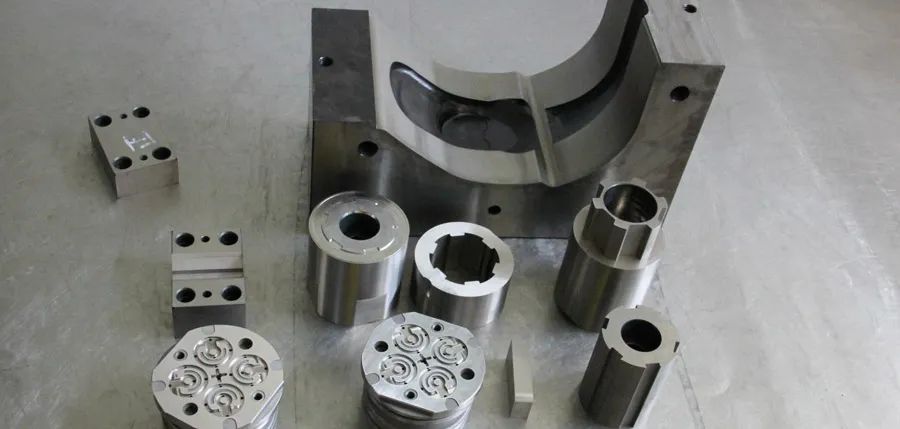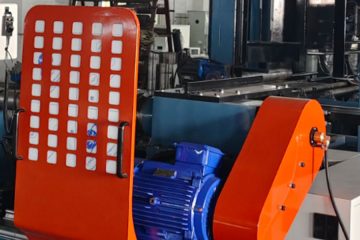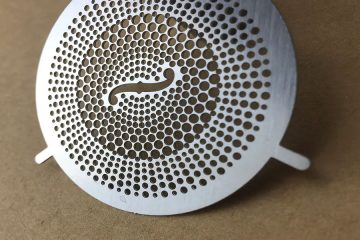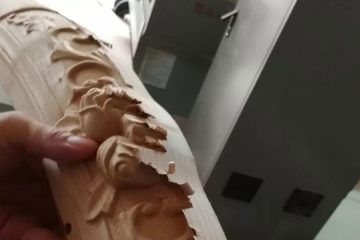EDM is a newer metalworking technique compared to rotary tooling, shearing and forging. A rapid pulsed high voltage discharge (spark) across the gap between the electrode and the grounded workpiece removes material from the workpiece by erosion. Even the hardest, most intractable materials can be cut and machined with little to no massive heating and little macroscopic force applied, as long as the material is conductive. This results in very low deformation and does not add meaningful residual stress to the workpiece.
The first EDM method was drilling EDM, developed by Stark, Harding, and Beaver (and Lazarenko in the Soviet Union). Its earliest application was in the mid-1940s for the removal of sheared bolts and taps in high value aluminum castings.
From this relatively simple drilling method, a second branch of EDM developed: stamping EDM or sinker EDM. This technique is essentially the same as EDM, except that a sophisticated form can be added to the end of the “drilled” electrode. This process produces finished, fine and precise cavity bottom shapes in one operation.
A third type of EDM is wire EDM, which uses a straight electrode to cut vertical or angled slots (slightly wider than the wire) as the wire is slowly fed through the kerf to keep the electrode “fresh” at all times.
This article will describe EDM, discuss the three main EDM methods, highlight important technical aspects of each method, and identify applications that use each EDM method. It will also focus on practical applications, selection of appropriate methods, and the main benefits of each.
Learn more about:What is Electro Chemical Machining
3 Types Of EDM

1.Wire-cut EDM
Wire-cut electrical discharge machining, commonly referred to as wire-cut EDM, uses a wire as a “knife” that erodes material by sparking between the wire and the workpiece. The wire electrode discharges along the entire length of the incision and penetrates, helping to remove swarf. The technique was developed as a way to make 2D cuts in hard materials (cuts can only be made along the x and y axes of the part, with the z axis being the thickness of the material), but its complexity has continued to increase. Offsetting the wire rolls from each other allows cutting at controlled angles relative to the z-axis. Later, it was also possible to add a rotary axis to the wire EDM process, resulting in a high-performance 5-axis wire EDM center.
This method allows free cutting. It is most commonly used to make extrusion tools and punches/die when combined with EDM drilling (for holding electrodes). Brass, galvanized brass and zinc diffused copper (layered wire) running on sapphire or diamond rails are used as electrodes during wire EDM. The various conductivity, hardness, and tensile strengths of wire electrodes provide different processing characteristics.
2.Sedimentation EDM
Subsidence electrical discharge machining (also known as “punching” or “cavity” EDM) uses electrical discharges from essentially 2D electrodes. This 2D electrode can have a complex 3D shaped tip, is inserted repeatedly to arc-erode the workpiece, and is raised a short distance in the Z-axis to remove debris. The electrode can have any cross-sectional shape and complex end shapes (no undercuts). For sedimentation EDM, a precision copper or graphite electrode is first machined into the desired cavity shape and then used to etch that shape into a hard material.
Stamping EDM is widely used in injection molding and die-casting tool manufacturing. It is used to create unmachinable complex and fine cavity features in molds without applying any machining or impact stress to the mold. It also reduces the need for post-treatment to improve surface quality or harden.
3.Drilling EDM
Drilling EDM was the first electrical discharge machining technique developed and remains a vital tool in a variety of fields, including rocket engines, gas discharge control in medical and scientific equipment, and open cooling channels in gas turbine blades. Small, long, straight holes can only be cut by EDM. Straight electrodes are used to erode holes that perfectly reflect the contour of the tool. It maintains precise dimensional accuracy along the entire length of the bore. This method allows the machining of small diameter, high aspect ratio, straight holes of any depth, 0.0015 inches in diameter or larger. EDM allows the drilling of blind and through holes, and can drill smooth walls in otherwise unmachineable materials, or achieve difficult geometries. The machined surface finish of the hole machined by EDM is smooth enough to be used as a bearing surface without additional machining steps.
What is EDM?
Electrical discharge machining (EDM) is a non-contact machining method used to cut unmachinable complex shapes and cavities in very hard, difficult-to-machine materials. When the workpiece and electrode are immersed in a dielectric fluid (usually paraffin or kerosene), the high potential at the electrode finds a path to ground through the workpiece. Each spark produces localized temperature peaks of up to 12,000°C. This temperature will melt/vaporize some of the workpiece (and electrode). Clearing cutting debris is important to avoid short circuits, so drills and punching tools are Z cycled, where the electrode feed for wire cutting achieves the same effect.
The EDM process produces no applied global stress in the workpiece, only limited, highly localized heating. This results in macroscopically stress-free machining. It can also cut very thin sections and delicate features that would otherwise fail mechanical tool-based machining. This technology has revolutionized many aspects of toolmaking. It removes the design constraints imposed by the need for rotating cutters, enabling complex functions that would otherwise be impossible.
Which EDM type is best for creating parts with complex cavities?
Subsidence EDM is the best type of EDM for manufacturing parts with complex cavities. It allows complex cavities often required in the design of plastic and die cast parts. The limitations on the cavity shapes that can be produced by sedimentation discharge EDM have little impact on its value as a moldmaking tool. The “pull wire” that prevents sparks from creating undercuts is also suitable for plastic molding and die-cast parts, which enter the tool cavity as a liquid but exit as a solid.
How Are The Types Of EDM Classified?
The various types of EDM are classified according to their operations and applications. For example, wire EDM uses a linearly fed wire electrode to make substantially 2D cuts. The electrode wires are on diamond or sapphire rails, the dielectric fluid is deionized water, and the electrodes are usually made of brass or galvanized brass.
On the other hand, sinker discharge EDM allows complex electrode shapes to be used to create equally complex cavities. Graphite or copper electrodes are pre-machined to the desired shape and then sunk into the workpiece by erosion, creating a hole that is the opposite shape of the electrode.
Drilling EDM can provide smaller and deeper holes than conventional drilling. This enables high precision diameter and roundness with good surface finish and no burrs. Electrodes can have complex cross-sectional shapes. Drilling tools often have cooling channels so media is pumped through to help remove cuttings.
What is the purpose of using EDM?
EDM can replace traditional machining techniques for hard materials, especially for machining refractory metals and difficult-to-cut shapes. Wire-cut EDM can achieve tolerances that are impossible in precision cutting, and drilling EDM can achieve tolerances in diameter and roundness. In general, EDM can maintain high precision and very low Ra levels (high quality surface finish). This capability reduces post-processing, often reducing the cost of difficult-to-manufacture components.
Where is EDM used?
Electrical discharge machining (EDM) is used to create molds for plastic injection molding and metal die casting. It is also used to create complex cavities in pre-hardened materials. EDM is particularly useful because of its ability to create precise and complex cavity shapes and make very deep cuts. The aerospace, automotive and electronics industries are also using EDM to create prototypes and production parts.
When should EDM be used?
You can use EDM for a variety of applications including: complex cavity shapes, i.e. 3D relief shapes cut on the underside of essentially 2D blind holes; extraction of precise 2D shapes from difficult-to-machine materials; easy deformation thin sections; and drilling fine and/or long holes in any metal. EDM exerts substantially no stress on the workpiece and can produce one-step drilling of any cross-section with a good surface finish.
What materials are used in EDM?
The materials most commonly machined by EDM are those that are difficult to machine by other means, such as: tungsten, molybdenum, and hardened tool steels. Materials that exhibit extreme work hardening during machining, such as titanium and austenitic stainless steels, are also good candidates for EDM. These materials become increasingly difficult to cut as they harden as they are processed. This hardening often reduces part feature accuracy.
Introduction to Be-cu:
Be-cu one-stop cloud manufacturing platform for mechanical parts, selected as a national service-oriented manufacturing demonstration platform, has connected 1,000+ high-quality factories, and provides parts rapid proofing and small batch testing for 40,000+ hardware manufacturing customers in 30+ countries and regions around the world Production, large-scale mass production in one of the non-standard parts processing services, covering machining, 3D printing, prototyping, sheet metal processing, injection molding. Click “Quote Now” to upload the drawing with one click, and get the quotation in 5 seconds.


